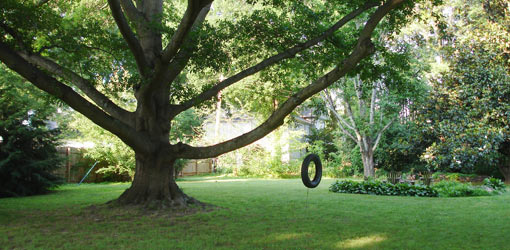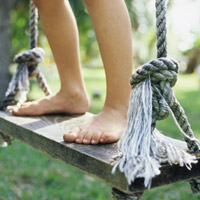How to Draw Tree Swing

Summertime is perfect for playing outdoors, and what backyard is complete without a tree swing?
Tree swings can provide years of fun, but it's important to install them in a way that guarantees both your safety as well as the health of the tree. Here are some tips for the safe installation of a tree swing.
Choosing a Tree and Branch for a Swing
When hanging a tree swing, be sure to consider:
-
- Tree Type: The branches of a sturdy hardwood tree are best for a tree swing – oaks are ideal. Avoid fruit trees, evergreens, or trees that split easily.
-
- Branch Size: A tree swing needs a horizontal branch at least 8 inches in diameter that is no more than 20 feet off the ground.
-
- Branch Condition: The branch chosen for a tree swing must be healthy. Inspect the branch from trunk to tip, and avoid branches that show any signs of infestation, disease, splitting, or narrow connections to the main trunk. And above all, don't use a dead branch!
- Clearance: The branch should be large enough that the swing can hang at least 3-5 feet away from the trunk without the branch bouncing.

How to Attach a Swing to a Tree
There is debate about the safest way to install a tree swing, but in general there are two main approaches:

Eye bolt
-
- Eye Bolts: Carefully drill a vertical hole all the way through the center of the branch, and insert a 1/2" diameter or larger, corrosion-resistant eye bolt, using washers and nuts to secure it to the tree. The tree will eventually grow around the bolts, making a permanent installation. This method eliminates friction on the bark, but it does cause damage to the tree. To make your rope last longer, attach a carabiner to the eye bolt, then tie the rope to the carabiner.
- Rope: A tree swing can be attached to the branch using rope as long as you take steps to prevent the rope from cutting into the tree bark. If you choose to tie the rope around the tree branch, use a running bowline (or other slip knot) that will loosen when the swing is not being used, to allow the tree to grow larger without being girdled by the rope. To protect the bark, use a rope sleeve or a piece of rubber tubing to reduce friction.
Choosing Rope for a Tree Swing
Use 1/2" diameter or thicker rope to make it easy to hold and provide enough strength. There are a number of materials used for rope, including:
-
- Polyester Rope: Braided polyester rope is probably the best rope choice among the synthetic ropes for a tree swing. It holds up well to the elements, provides maximum strength, and has little stretch.

Braided polyester rope
-
- Nylon Rope: While the strongest rope, nylon is susceptible to stretching and can be slippery for little hands to grasp.
-
- Polypropylene Rope: This lightweight rope is the least expensive rope available. Polypropylene rope makes a poor choice since it deteriorates rapidly in the sun's UV rays.
-
- Natural Fiber Rope: These include ropes made from natural plant materials including manila, cotton, sisal, and hemp. While popular for rustic tree swings, natural fiber ropes are not as strong as synthetic rope, will rot over time, and can break without warning. If you use a natural fiber rope on a tree swing, be sure to replace it every year or two.
- Metal Chain: While not as attractive as rope with a tendency to pinch small fingers, corrosion-resistant chain is strong and holds up well to the elements. Chain should only be used for swings installed with eye bolts, and not attached around a tree branch.
Tree Swing Safety Tips
Follow these tips to maximize the safety and enjoyment of your tree swing:

-
- Inspect the tree branch, as well as the ropes and swing itself, regularly. Look for splitting, fraying, missing bark, or other damage, and repair right away. A properly installed swing should not cause any damage or grooves in the tree.
-
- Plan on replacing the ropes every couple of years.
-
- Move the swing to new eye bolts if the tree grows over the ends.
-
- Make sure the rope, carabiners, and hardware are rated for the maximum weight.
- Be sure knots are tied securely to prevent unraveling.
Further Information
- Hanging a Tree Swing (This Old House)
- Swing into Fall with a Tree Swing (Mother Earth News)
- How to Build a Tree Swing (This Old House)
- Tree Swing (Martha Stewart)
- Rope Materials (boatsafe.com)
Source: https://todayshomeowner.com/how-to-install-a-tree-swing-safely/